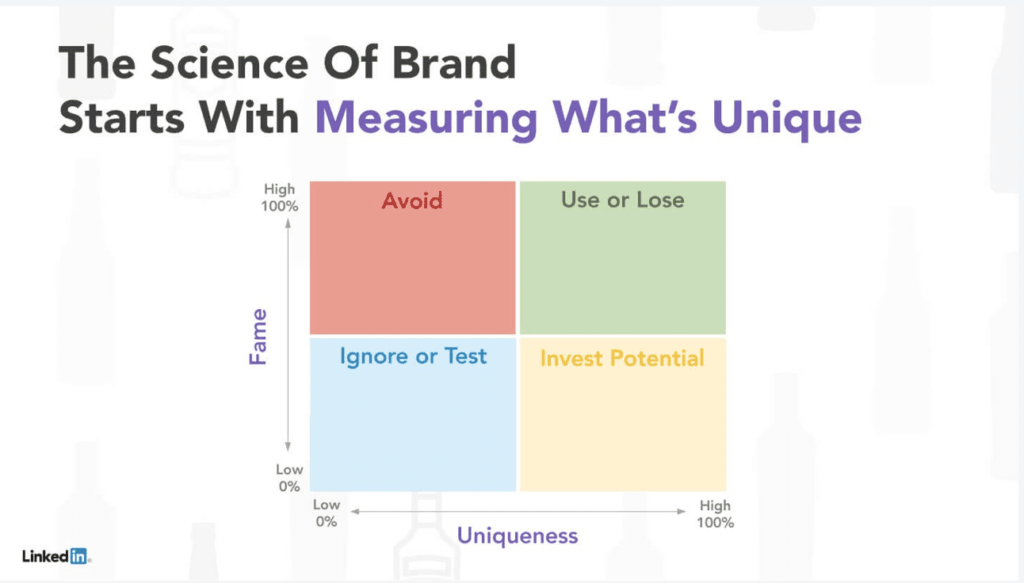How often do you think potential clients mistake your brand’s marketing for one of your competitors?
5% of the time? 10%?
Well, according to LinkedIn, that number is closer to 50%. So a full half of your potential clients are seeing your ads, social posts, and other marketing collateral and thinking of, possibly buying from, one of your competitors instead of you.
This is a problem that needs to be addressed.
In this post, we’ll discuss why this happens, and how brands can invest in B2B branding to make themselves even more memorable.
Brand awareness doesn’t go far enough.
We’ve said it before and we’ll keep on saying it: brand awareness is table stakes these days.
In order to grow, B2B brands need to go beyond creating a b2b brand awareness strategy and set their sights on becoming famous. In other words, you want your brand to be the first one that comes to mind when a potential client thinks of your industry or product.
There are two reasons B2B businesses need to go this extra mile today:
- Buyers have never had more choice when it comes to the products and services they purchase.
- Buyers have never had more power when it comes to directing and influencing the purchase process.
Let’s think about what this means.

One of the first things a B2B buyer does when they start researching vendors is to Google them. They might use an industry keyword, search for the “best” product/service they’re trying to purchase, or even type in a brand name of a vendor they’re already familiar with.
That search brings up a bunch of options that they then start wading through to begin their research in earnest. Naturally, they’ll gravitate toward the top two or three results—and if they find something that matches what they’re looking for, they may not even bother searching further.
This all results in B2B brands having little control over when and how those potential buyers are finding their companies. And that’s why SEO, content marketing, social media marketing, and other inbound strategies are so critical in staying afloat—you want to be as close to that first page of search engine results as possible.
But that’s just one aspect of the issue. People aren’t robots, after all, and they’re governed as much, if not more, by the recommendations from colleagues, brand familiarity, and long-term ways of thinking as they are by search results.
That’s why the term “shoes” has roughly 1.2 million Google searches per month, but the term “Nike” gets more than 5 million. That’s the power of fame when it comes to branding: people use your brand name as shorthand for the product they’re seeking.
If you can get your clients to just type in your brand name from the get-go, think how far ahead of the competition you’ll be. Not all who search for you will become paying clients—but they will have skipped over a significant portion of the buying journey. Therefore, they’ll have also skipped over plenty of opportunities to fall away from your brand and start looking at competitors.
So much for the choice aspect.
Now let’s think about the power side of the buyer journey. Research shows that B2B buyers now complete 67% of their buying journey digitally.
This doesn’t necessarily mean they’re not talking to salespeople at all during that period, as Forrester points out, but it does mean that sales has to meet much higher standards of value provision.
It also means that a huge chunk of your potential buyers are looking into your brand before you even know they exist. These days, not only do B2B brands not control every touchpoint, they don’t even get to know every touchpoint. So brands need to make the most out of every touchpoint they can create: content downloads, social interactions, PPC ads, etc.
How to make your B2B branding unmistakable
The only way to ensure that your brand isn’t mistaken for a competitor is to go all-in on your branding.
This goes beyond colors and fonts and should extend to everything from your website to the content and social posts you put out.
B2B branding is a detail-oriented, time-intensive endeavor, but one that can’t be overlooked.
The other element of creating a truly distinctive, memorable brand is uniqueness. If your branding is cohesive, but not unique, you still run the risk of fading into the sea of your competitors.
To help, here’s a matrix developed by the Ehrenberg-Bass Institute For Marketing Strategies.

As you can see, the axes are “Fame” and “Uniqueness.” You can run each aspect of your B2B branding through this matrix to see where you stand, and whether you need to make changes.
For example, Zen’s distinctive color purple ranks high on the uniqueness scale—hardly any other marketing or PR agency uses it—and middle-to-high on the fame scale, as many, but not all, of the clients and potential clients we talk to associate the color with Zen and only Zen.
If you were to apply this to the assets of a major brand, like the Nike swoosh, you’d get a very high level of both uniqueness and fame. Nike’s font would score relatively high on both as well, but not as high as the swoosh.
Branding is the future of not just marketing, but sales, too. Ready to take your brand to the next level? Get in touch!




